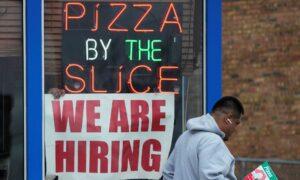The producer price index (PPI) advanced to an annualized rate of 1.6 percent, up from 0.8 percent in the previous month. This also came in higher than the market forecast of 1.2 percent.
Prices for goods accelerated by 2 percent, fueled mainly by a nearly 11 percent spike in energy costs. Prices for services inched higher by 0.2 percent, driven by a 1.4 percent boost to higher transportation and warehousing costs.
Core wholesale prices, which omit the volatile energy and food components, edged up by a slightly higher-than-expected 0.3 percent on a month-over-month basis, down from 0.4 percent. Core PPI was unchanged at 2.2 percent, the lowest reading since January 2021.
Overall, commodities were the driving force behind the increase.
“Over 60 percent of the August rise in the index for final demand goods can be traced to prices for gasoline, which jumped 20.0 percent,” the BLS said. “The indexes for diesel fuel, jet fuel, home heating oil, beverages and beverage materials, and iron and steel scrap also moved higher. Conversely, prices for fresh and dry vegetables fell 11.5 percent.”
Diesel fuel prices soared by more than 41 percent, jet fuel prices surged by close to 24 percent, home heating oil and distillates prices swelled by 18 percent, beef prices increased by more than 16 percent, and coffee prices jumped by nearly 14 percent.
Economists paid closer attention to wholesale prices because they’re typically a leading index for broader consumer prices. The PPI measures what companies pay for supplies, such as fuel and packaging. These costs are then passed on to shoppers, revealing if inflation is trending higher or lower.
The ascent in wholesale prices over the past two-plus years—PPI is up by 17.6 percent since March 2021—is affecting small businesses, Sen. Rick Scott (R-Fl.) said.
PPI and the FFR
Following a year of slowing price growth, the new concern is whether headline inflation will begin a renewed upward trajectory, particularly with oil and gas prices soaring amid global supply deficit fears.Despite the two consecutive months of increases, the public shouldn’t expect the Federal Reserve to panic and mirror its tightening efforts of the past 18 months.
According to the CME FedWatch Tool, the futures market is pricing in a rate pause at this month’s Federal Open Market Committee policy meeting, leaving the benchmark fed funds rate at a target range of 5.25 percent to 5.5 percent. But there’s some movement on whether the central bank will pull the trigger on a quarter-point rate hike at the November meeting.
Chicago Fed Bank President Austan Goolsbee believes the institution is almost finished raising rates, telling NPR’s Marketplace on Sept. 7 that the next discussion will be how long rates need to be higher to achieve the Fed’s 2 percent inflation target rate.
“We are very rapidly approaching the time when our argument isn’t going to be about how high should the rates go,” Mr. Goolsbee said.
Monetary policymakers worldwide will continue to contend with reining in inflation and maintaining steady economic growth.
The European Central Bank (ECB) raised its key interest rates by 25 basis points to record highs. ECB officials acknowledged that the eurozone economy is slowing but emphasized the need to combat stubborn and sticky inflation.
ECB staff forecasts average inflation to be 5.6 percent this year, 3.2 percent in 2024, and 2.1 percent in 2025.

“Inflation continues to decline but is still expected to remain too high for too long. The Governing Council is determined to ensure that inflation returns to its 2% medium-term target in a timely manner,” the ECB said in a statement.
This month, various metrics pointed to a sluggish economic climate in Europe. The second-quarter GDP growth rate was 0.1 percent, retail sales tumbled by 0.2 percent in July, manufacturing activity contracted in August, and industrial production fell by 1.1 percent in July.
By comparison, the United States economy is holding steady.
Retail sales surged by 0.6 percent last month, up from 0.5 percent in July and higher than the market estimate of 0.2 percent, according to the Census Bureau. This represented the fifth straight month of growing retail trade.
The Atlanta Fed Bank’s GDPNow model estimate points to a third-quarter expansion of 4.9 percent. The New York Fed’s Nowcast expects 2.2 percent growth.







